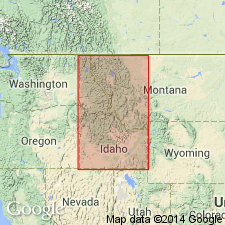
- Usage in publication:
-
- Thorn Creek Beds
- Modifications:
-
- Original reference
- Dominant lithology:
-
- Conglomerate
- Sandstone
- Shale
- AAPG geologic province:
-
- Great Basin province
Summary:
Pg. 93. Thorn Creek Beds of Idaho Group. Thorn Creek flora was collected at locality south of Idaho City, southern Idaho, in lower drainage of Thorn Creek. Basal part of section is granite boulder conglemerate about 75 feet thick; faulted against granitic basement. Overlying rocks are chiefly thick cross-bedded arkose and arkosic conglomerate interspersed with fine-grained thin sandstones and pumiceous shale, the latter ranging from a few inches up to 3 feet thick. Flora is preserved in thin lens of reddish-brown ashy shale in upper third of the 600-foot section. This section has been referred to Payette formation, but it represents lower part of Idaho group. The formation is herein referred to provisionally as Thorn Creek beds. Age is middle Miocene.
Occurs about 10 mi south of Idaho City, [approx. Lat. 43 deg. 44 min. 15 sec. N., Long. 115 deg. 51 min. 45 sec. W., Boise Co., Boise National Forest], southern ID, in lower drainage of Thorn Creek. Formation exposed as asymmetrical syncline, with east flank dipping 60 deg. W., and west flank dipping 5 to 7 deg. E. West limb truncated by high-angle normal fault that trends northerly. [Additional locality information from Acme Mapper 2.0, accessed April 1, 2010.]
Source: US geologic names lexicon (USGS Bull. 1350, p. 756).
For more information, please contact Nancy Stamm, Geologic Names Committee Secretary.
Asterisk (*) indicates published by U.S. Geological Survey authors.
"No current usage" (†) implies that a name has been abandoned or has fallen into disuse. Former usage and, if known, replacement name given in parentheses ( ).
Slash (/) indicates name conflicts with nomenclatural guidelines (CSN, 1933; ACSN, 1961, 1970; NACSN, 1983, 2005, 2021). May be explained within brackets ([ ]).

